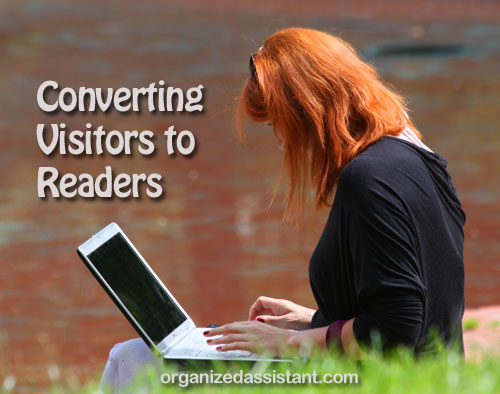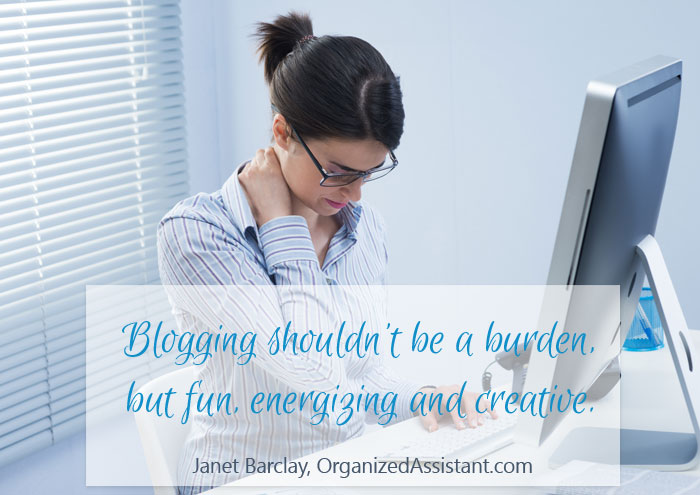5 ways to convert visitors to blog readers
This page may contain links to Amazon.com or other sites from which I may receive commission on purchases you make after clicking on such links. Read my full Disclosure Policy

I recently suggested a few ways to drive new traffic to your blog. Once you’ve succeeded in attracting new visitors to your site, your next goal is to keep them there. The more time they spend on your blog, the more opportunity you have to make a lasting impression.
To keep people on your blog longer, you need to ensure that they can find the information that interests them, quickly and easily.
The most common way to do this is to organize your posts into categories and tags. As explained in my post, How well-organized is your blog?, categories are typically fairly broad, whereas tags are much more specific. For example, if one of your categories is Business Organizing, your tags could include anything from filing, to office organization, to time management.
Linking between posts, as I’ve done in the previous sentence and at the end of this post, is another way you can make it easy for readers to find the information they need.
If you have more than 50 posts, consider adding a search box. If I have to scroll through pages and pages on your blog to find the answer to my question, I’m sorry, but I’m going to go somewhere else for that information.
Another feature that adds a nice touch is a “top content” list.
You can use a plugin, such as Top 10 to automatically generate a list of the posts with the most views, or you can create your own list of your most important posts. I don’t see this feature often, but if you’ve written a series of posts, it could be a great way to bring them to the attention of newer readers.
Remove the clutter.
It’s surprising, but I’ve seen a lot of professional organizer websites that were pretty cluttered.
In my presentation, How to Write Blog Posts that Get Results, I stated that every word in your blog post should have a reason for being there. Well, every single item on your site should also have a reason for being there!
Do you need two sidebars? Do you even need one?
What about all those widgets? Does anyone actually use your Archives by date, for example?
Here’s another example. Posting a blogroll, or list of your favorite blogs, is a nice thing to do, both for your readers and the bloggers you link to, but does it need to be in the sidebar of every page? Wouldn’t it be better to put it on its own page where it’s not distracting readers from the content you’ve worked so hard to develop?
Ultimately, you want your blog to look as professional and as organized as you do.
On that note, pay attention to your branding.
In most cases, your blog should be part of your website, especially if you’re blogging to market your business. If you choose to keep it separate, it doesn’t have to look exactly like your website, but it should have a consistent look and feel so people can easily make the connection.
If you’re blogging on Blogger, WordPress.com, or another free blogging site, please get your own domain name. It’s just a small investment, but it makes a big difference to your professional image.
Introduce yourself to your readers.
With millions of blogs on the Internet, there’s no shortage of information for people who need help with productivity and organization. What makes your blog different from all the others is YOU. Instead of hiding behind your business name, identify yourself as the author. Introduce yourself as you would to someone you met at a casual networking event, and include a picture of yourself.
And don’t forget to add a Call to Action to your About page! It may be as simple as inviting visitors to connect with you on social media. They may not become regular readers right away, but seeing your new posts in their newsfeed will encourage them to come back.
Want more tips like these? Sign up to receive new posts from Your Organizing Business in your inbox once per week by filling out the form at the bottom of this page.
Image © Alicja Stolarczyk / FreeImages.com




Another great post, Janet. I feel the same about the “cluttered” site. It’s a tough battle because a lot of linkys and groups want you to post their button, which can get cluttered. I’m trying to keep this to minimum. Love learning from you:)
I know what you mean, Seana, and so far I think you’re doing just fine. 🙂 I see some sites with multiple menu bars, plus a sidebar down each side, and it’s hard to figure out where you’re supposed to actually look!
Great post and tips Janet! It’s so tempting to clutter up the space with all sorts of information and I have to keep reminding myself what are my goals when deciding what stays and what goes on the blog and site in general.
Will go back and re-check! 😀
Just like in our homes and offices, sometimes the clutter sneaks up on us, as we add new things over time. Then one day you look at it and go “Yikes!”
Great post, Janet. I also agree with clutter on sites. I only allow one column and the content in the widgets have to pertain to organizing. Updating yearly “about me” page content is important too. Also, making sure photos are not too big and are labeled correctly also helps in the appearance of the site. Thanks for sharing your great knowledge on this topic.
Great reminder about updating your About page! People often forget to add certifications and awards, or to change personal details that are no longer accurate.
Many themes allow you to insert different widgets on different pages, or rotate what comes up, so you can include lots of content without making your sidebar too busy.
Thank you Janet! I was inspired to unclutter my blog!!
solutionsforyouorganizing.blogspot.com
Yay, Anne! I don’t remember what it looked like before, but it’s nice and tidy now!